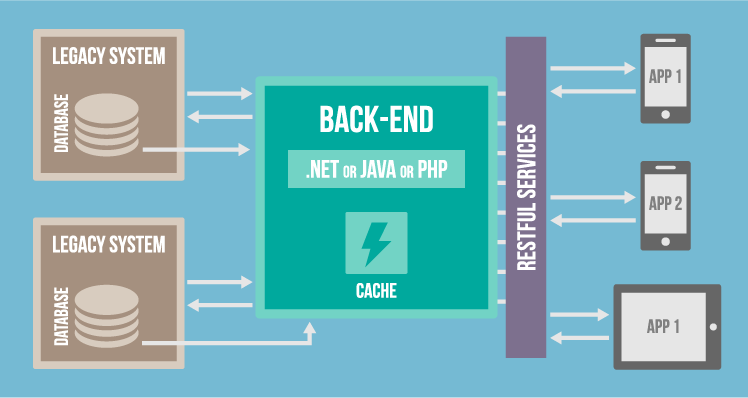How to Integrate an App with a Legacy System
Editor’s note: Andrei explains the challenges of integrating a modern mobile enterprise app with a legacy system and shares the winning ways to tackle them. If you want to integrate enterprise solutions promptly and with minimal disruption to your business workflows, you’re welcome to turn to ScienceSoft for IT system integration services.
Technologies described as “cutting-edge, innovative and outstanding” do not seem that alluring to everyone. For businesses built on solid 10-year-old platforms, these words are, actually, terrifying. But it’s impossible to ignore innovations forever: by staying conservative, companies can’t improve their internal processes and, therefore, client services, which leads to both financial and customer losses.
Integration challenges
What mobile enterprise applications present is an abundance of the widely welcomed convenience – for both the employees and the administration. However, surveys show how contradictive the reality is: while 43% of companies see mobility as the most influential business success factor, the exact same figure of 43% – of IT executives this time – think that, since mobile enterprise applications sometimes need to be integrated into the legacy system, they bring more problems than they solve.
Indeed, in order to perform integration, the system should be either replaced or profoundly upgraded. The first option, no matter how risky and costly it is, is not out of companies’ consideration. The poll among insurance organizations, for instance, revealed that 42% of the industry’s CIOs would agree to adopt new systems, as by using legacy platforms they felt like missing new business opportunities. But a temporary discontinuation of the workflow, as well as budget investment in the development of a new business core instead of the already existing, perfectly functioning one – all for the sake of a mobile application – sounds a bit over the top.
Another option – modernization of the corporate system – is a more reasonable choice that neither requires extensive budget nor holds all the companies processes back. Nevertheless, as the business core is deeply involved in the modernization process, both the workflow stability and platform intactness are exposed to certain risks.
Creating a backend
The 3rd and the best alternative, according to ScienceSoft’s expertise in mobile enterprise apps development, is to create “middleware” – a .NET/Java/PHP-based mobile backend that plays a role of an intermediary in communication between a legacy platform and a mobile application.
Considering that many companies had their basic software created in 1980/90s and now face difficulties finding specialists who can maintain it, the sole fact of using today’s most popular languages is the advantage of this approach. But it has many other pros.

Advantages
First of all, such technique doesn’t involve any actual upgrade of the existing legacy core, in this manner reducing the risks that influence CIOs and make them choose platform replacement. The middleware freely communicates with the platform, sends and receives information in the simplest, understandable by any legacy platform way – but is, in fact, completely independent from it.
Secondly, the mobile enterprise application itself in this case is much less overloaded. The backend spares it the integration settings and serves as a channel that, depending on the legacy software nature, can transfer files or, in the worst case, use direct access to the database.
Moreover, the backend can be programmed to process complex tasks and manage them on behalf of the application, while the app itself is not overburdened with code and remains light and agile.
The major advantage is, of course, the quality of integration. The development of a mobile backend means a free use of RESTful services that are mostly not provided by legacy systems but are perfect for integrating a mobile app with current software. With their help, a mobile enterprise application will be able to communicate with existing business systems, including CRM, ERP and corporate portal, and provide easy access to them from any employee’s mobile device.
Lastly, with the middleware and the core platform having their own securities, the protection level of access and data conveyance literally doubles, which is by far not a trivial factor for any enterprise.
Recap
Integration of an enterprise application with the legacy system isn’t as difficult as it may seem and doesn’t necessarily mean replacement of the existing software. ScienceSoft believes that it’s not the legacy system that should cave in to the new technologies, but a mobile application should pay its respect to the older ones – therefore we support the mobile backend development approach and actively use it in practice. Creating a powerful and smart “intermediary” is profitable in many ways and even allows you to create and integrate not one but many mobile applications in your organization’s workflow.

